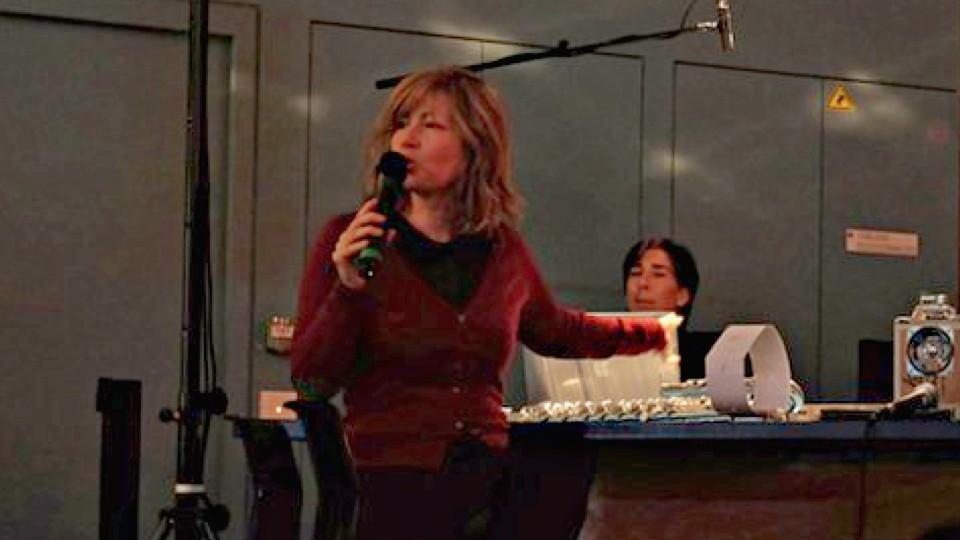Creating and expanding electronic musical instruments
Primary page content
Dr Patricia Alessandrini has spent the last year re-imagining the traditional piano using physical computing methods.

Dr Patricia Alessandrini
A Lecturer in Sonic and Arts, Dr Alessandrini is a composer and sound artist and also heads the Unit for Sound Practice Research.
She is working on her latest project 'Orpheus Machines' with Goldsmiths colleague Dr Freida Abtan, and is set to perform at the Huddersfield Contemporary Music Festival for the second consecutive year on 23 November.
I spoke to her about her plans for the festival, her previous research and how to turn a household iron into a musical instrument.
Chris Smith: Can you explain a little about how your new piano will work?
Patricia Alessandrini: A previous collaborative project entitled ‘Orpheus Machines’, involved a series of pieces developed by myself and my Goldsmiths colleague Dr Freida Abtan, for period keyboard instruments using physical computing techniques to mechanically excite the strings. Building on this, I am now collaborating with another Goldsmiths colleague, Konstantin Leonenko, to create a system that gently excites the strings of the piano, so that they produce a somewhat sustained but textured sound when the keys are depressed silently. The aim is to produce a sound as if the strings are being gently but vigorously stroked, while one is nonetheless playing on the keys.
CS: What will your participation at the Huddersfield Contemporary Music Festival involve?
PA: On 23 November, Explore Ensemble will premiere a composition of mine commissioned by the HCMF, entitled ‘Tracer La Lune’, which will feature the electronically-augmented piano we are developing as part of the project mentioned above. They will perform the same work at Oxford University, along with a research presentation on the project, and then at Goldsmiths, in Deptford Town Hall, on 28 November. Event information here.
This is the second time in recent years Goldsmiths has invited a contemporary music ensemble to develop new work with electronics with me and present it in concert here and elsewhere, along with other events such as open rehearsals and research presentations. In 2015, we welcomed Ensemble Interface, an ensemble based in Cologne, and in Spring of 2018 we plan to host another London-based group, the Riot Ensemble.
CS: What other instruments have you developed in your past research?
PA: Transforming or ‘augmenting’ existing musical instruments through electronics has been a central research theme for me over the past several years. While we tend to generally associate electronic music with the diffusion of sound through a speaker array, I have been focussing on using digital means to make instruments or objects produce sound. For instance, in 2010 I created an installation entitled ‘Adagio sans quatuor’, which replaced the four string players of a quartet with four large metal plates which produced a version of a Mozart quartet through their vibrations, tuning themselves with slow bending movements.
This work has developed alongside of that of other sound artists working with similar materials, such as Savannah Agger and Jean-Francois Laporte, and has been informed by exchanges with researchers such as Adrien Mamou-Mani, who worked for several years at the Institut de Recherche et Coordination Acoustique/Musique (IRCAM) on a project called Smart Instruments, which consisted of integrating electronics processing into musical instruments.
CS: What other objects have you made into musical instruments?
PA: Earlier this year, I presented a project at the Edinburgh International Science Festival – and later, at the Conservatoire de Paris - called ‘Parlour Sounds’, in which we created self-contained electronic instruments from household appliances to create electronic music. An example of this is an iron which captures the voice of the user with a tiny microphone placed inside of it, in order to ‘tune’ its electronic sound, which may then be modulated through the movements of the iron.
This featured as one of several augmented ‘vintage’ objects in a theatre performance which presented a feminist viewpoint of technology. Set in a British home in the late ‘60s, it saw the soprano, Peyee Chen, interact with the technology she finds at home in order subvert the function of housekeeping devices and her role in the household and relationship to technology.
CS: How important do you think electronics are in contemporary music?
PA: One of the most exciting roles for electronics in contemporary music is to redefine the relationship between a performer and his/her instrument, potentially enhance and facilitate performance and introduce new possibilities for musical expression. One example of engaging with this relationship is my collaborative project with Seth Woods entitled ‘Bodied Chambers’, in which the technology was wearable, such that he captured the sound of the cello and transmitted sound into its resonant body through the contact of the instrument with his own body.
Electronics can also play an important role in designing instruments for the differing physical needs of different performers. Throughout my time at Goldsmiths, I have been active in this area, particularly through my work in designing instruments for inclusive performance for Share Music – Sweden. Electronic instrument design for inclusive practice is a key area of research at Goldsmiths, and a part of the larger theme of embodied interaction, so contact with colleagues in Computing such as Dr Rebecca Fiebrink, Dr Mick Grierson and Professor Atau Tanaka has been crucial to my own research, as well as consultations with external experts such as Clarence Adoo, one of the founding members of the British Paraorchestra.